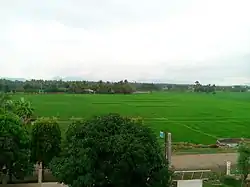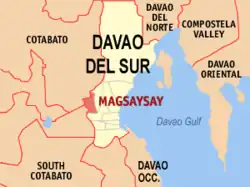Magsaysay | |
|---|---|
| Municipality of Magsaysay | |
 Rice granary | |
 Flag  Seal | |
 Map of Davao del Sur with Magsaysay highlighted | |
OpenStreetMap | |
.svg.png.webp) Magsaysay Location within the Philippines | |
| Coordinates: 6°46′N 125°11′E / 6.77°N 125.18°E | |
| Country | Philippines |
| Region | Davao Region |
| Province | Davao del Sur |
| District | Lone district |
| Founded | June 17, 1967 |
| Named for | Ramon Magsaysay |
| Barangays | 22 (see Barangays) |
| Government | |
| • Type | Sangguniang Bayan |
| • Mayor | Ronie Lagmay Sarande |
| • Vice Mayor | Engr. Arthur Dedace Davin, C.E. |
| • Representative | John Tracy Fortich Cagas |
| • Municipal Council | Members |
| • Electorate | 38,336 voters (2022) |
| Area | |
| • Total | 268.09 km2 (103.51 sq mi) |
| Elevation | 723 m (2,372 ft) |
| Highest elevation | 1,322 m (4,337 ft) |
| Lowest elevation | 418 m (1,371 ft) |
| Population (2020 census)[3] | |
| • Total | 56,263 |
| • Density | 210/km2 (540/sq mi) |
| • Households | 15,398 |
| Economy | |
| • Income class | 3rd municipal income class |
| • Poverty incidence | 23.54 |
| • Revenue | ₱ 218.9 million (2020) |
| • Assets | ₱ 560.4 million (2020) |
| • Expenditure | ₱ 280.9 million (2020) |
| • Liabilities | ₱ 205 million (2020) |
| Service provider | |
| • Electricity | Davao del Sur Electric Cooperative (DASURECO) |
| Time zone | UTC+8 (PST) |
| ZIP code | 8004 |
| PSGC | |
| IDD : area code | +63 (0)82 |
| Native languages | Davawenyo Cebuano Kalagan Tagalog Ata Manobo |
Magsaysay, officially the Municipality of Magsaysay (Cebuano: Lungsod sa Magsaysay; Tagalog: Bayan ng Magsaysay), is a 3rd class municipality in the province of Davao del Sur, Philippines. According to the 2020 census, it has a population of 56,263 people.[3]
As with much of the rural area of Davao del Sur, the predominant economic activity is based on rice farming.
History
The whole area under jurisdiction of the municipality of Magsaysay were all once part of Bansalan. It was populated firstly by Bagobos and Manobos until settlers from the Visayas came to the area and eventually became the dominant ethnicity of the area. The most populous village in the area was Kialeg, now the town center, which was renamed Magsaysay in 1959 in honor of the late president Ramon Magsaysay.[5]
The municipality of Magsaysay was created from 18 barangays of Bansalan on June 17, 1967 signed by President Ferdinand Marcos.[6] Barangay Magsaysay, formerly and still colloquially known in the present as Kialeg, became the town center of the newly created municipality and was thus was officially renamed Barangay Poblacion.
A magnitude 6.3 earthquake struck at Magsaysay on February 7, 2021, resulting in some damage to property to the nearby towns and cities.[7]
Geography
Barangays
Magsaysay is politically subdivided into 22 barangays. Each barangay consists of puroks while some have sitios.
- Bacungan
- Balnate
- Barayong
- Blocon
- Dalawinon
- Dalumay
- Glamang
- Kanapulo
- Kasuga
- Lower Bala
- Mabini
- Malawanit
- Malongon
- New Ilocos
- Poblacion (Kialeg)
- San Isidro
- San Miguel
- Tacul
- Tagaytay
- Upper Bala
- Maibo
- New Opon
Climate
| Climate data for Magsaysay, Davao del Sur | |||||||||||||
|---|---|---|---|---|---|---|---|---|---|---|---|---|---|
| Month | Jan | Feb | Mar | Apr | May | Jun | Jul | Aug | Sep | Oct | Nov | Dec | Year |
| Mean daily maximum °C (°F) | 30 (86) |
30 (86) |
31 (88) |
31 (88) |
30 (86) |
29 (84) |
29 (84) |
29 (84) |
30 (86) |
30 (86) |
30 (86) |
30 (86) |
30 (86) |
| Mean daily minimum °C (°F) | 22 (72) |
22 (72) |
22 (72) |
23 (73) |
24 (75) |
23 (73) |
23 (73) |
23 (73) |
23 (73) |
23 (73) |
23 (73) |
23 (73) |
23 (73) |
| Average precipitation mm (inches) | 59 (2.3) |
46 (1.8) |
41 (1.6) |
54 (2.1) |
105 (4.1) |
159 (6.3) |
179 (7.0) |
197 (7.8) |
162 (6.4) |
147 (5.8) |
102 (4.0) |
65 (2.6) |
1,316 (51.8) |
| Average rainy days | 12.3 | 11.7 | 12.2 | 14.5 | 22.6 | 25.6 | 26.6 | 27.5 | 25.5 | 26.0 | 21.2 | 16.0 | 241.7 |
| Source: Meteoblue[8] | |||||||||||||
Demographics
| Year | Pop. | ±% p.a. |
|---|---|---|
| 1970 | 30,920 | — |
| 1975 | 28,531 | −1.60% |
| 1980 | 31,538 | +2.02% |
| 1990 | 38,531 | +2.02% |
| 1995 | 41,979 | +1.62% |
| 2000 | 43,172 | +0.60% |
| 2007 | 45,005 | +0.58% |
| 2010 | 49,141 | +3.25% |
| 2015 | 53,876 | +1.77% |
| 2020 | 56,263 | +0.86% |
| Source: Philippine Statistics Authority[9][10][11][12] | ||
Economy
Media
- Kastigador Balita Mindanao (Weekly Newspaper)
- 95.3 MHz DXET Radyo Kastigo Magsaysay
References
- ↑ Municipality of Magsaysay | (DILG)
- ↑ "2015 Census of Population, Report No. 3 – Population, Land Area, and Population Density" (PDF). Philippine Statistics Authority. Quezon City, Philippines. August 2016. ISSN 0117-1453. Archived (PDF) from the original on May 25, 2021. Retrieved July 16, 2021.
- 1 2 Census of Population (2020). "Region XI (Davao Region)". Total Population by Province, City, Municipality and Barangay. Philippine Statistics Authority. Retrieved 8 July 2021.
- ↑ "PSA Releases the 2018 Municipal and City Level Poverty Estimates". Philippine Statistics Authority. 15 December 2021. Retrieved 22 January 2022.
- ↑ "R.A. No. 2106, An Act Changing the Name of the Barrio of Kialeg in the Municipality of Bansalan, Province of Davao, to Barrio Magsaysay". LawPH.com. Archived from the original on 2012-07-10. Retrieved 2011-04-13.
- ↑ "AN ACT CREATING THE MUNICIPALITY OF MAGSAYSAY IN THE PROVINCE OF DAVAO". Retrieved 26 August 2021.
- ↑ "Magnitude 6.3 earthquake rattles Davao del Sur". Retrieved 26 August 2021.
- ↑ "Magsaysay: Average Temperatures and Rainfall". Meteoblue. Retrieved 28 January 2020.
- ↑ Census of Population (2015). "Region XI (Davao Region)". Total Population by Province, City, Municipality and Barangay. Philippine Statistics Authority. Retrieved 20 June 2016.
- ↑ Census of Population and Housing (2010). "Region XI (Davao Region)" (PDF). Total Population by Province, City, Municipality and Barangay. National Statistics Office. Retrieved 29 June 2016.
- ↑ Censuses of Population (1903–2007). "Region XI (Davao Region)". Table 1. Population Enumerated in Various Censuses by Province/Highly Urbanized City: 1903 to 2007. National Statistics Office.
{{cite encyclopedia}}: CS1 maint: numeric names: authors list (link) - ↑ "Province of Davao del Sur". Municipality Population Data. Local Water Utilities Administration Research Division. Retrieved 17 December 2016.
- ↑ "Poverty incidence (PI):". Philippine Statistics Authority. Retrieved December 28, 2020.
- ↑ "Estimation of Local Poverty in the Philippines" (PDF). Philippine Statistics Authority. 29 November 2005.
- ↑ "2003 City and Municipal Level Poverty Estimates" (PDF). Philippine Statistics Authority. 23 March 2009.
- ↑ "City and Municipal Level Poverty Estimates; 2006 and 2009" (PDF). Philippine Statistics Authority. 3 August 2012.
- ↑ "2012 Municipal and City Level Poverty Estimates" (PDF). Philippine Statistics Authority. 31 May 2016.
- ↑ "Municipal and City Level Small Area Poverty Estimates; 2009, 2012 and 2015". Philippine Statistics Authority. 10 July 2019.
- ↑ "PSA Releases the 2018 Municipal and City Level Poverty Estimates". Philippine Statistics Authority. 15 December 2021. Retrieved 22 January 2022.
External links
- Magsaysay Profile at the DTI Cities and Municipalities Competitive Index
- Philippine Standard Geographic Code
- Philippine Census Information
- Local Governance Performance Management System